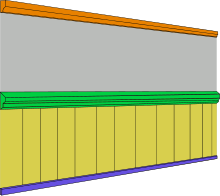| This article needs additional citations for verification. Please help improve this article by adding citations to reliable sources. Unsourced material may be challenged and removed. Find sources: "Baseboard" – news · newspapers · books · scholar · JSTOR (March 2013) (Learn how and when to remove this message) |

crown moulding dado rail dado baseboard / skirting board
In architecture, a baseboard (also called skirting board, skirting, wainscoting, mopboard, trim, floor molding, or base molding) is usually wooden, MDF or vinyl board covering the lowest part of an interior wall. Its purpose is to cover the joint between the wall surface and the floor. It covers the uneven edge of flooring next to the wall; protects the wall from kicks, abrasion, and furniture; and can serve as a decorative molding.
At its simplest, baseboard consists of a simple plank nailed, screwed or glued to the wall; however, particularly in older houses, it can be made up of a number of moldings for decoration. A baseboard differs from a wainscot; a wainscot typically covers from the floor to around 1-1.5 metres (3' to 5') high (waist or chest height), whereas a baseboard is typically under 0.2 metres (8") high (ankle height).
Plastic baseboard comes in various plastic compounds, the most common of which is UPVC. It is usually available in white or a flexible version in several colors and is usually glued to the wall. Vinyl baseboard is glued with adhesive and can be difficult to remove or to replace. It has a long lifespan, which can mean lower maintenance.
Wooden baseboard can be available in untreated, lacquered or prepainted versions. Prepainted baseboards can be made from a single piece or finger jointed wood, often softwoods, while hardwoods are either lacquered, or raw for staining and made from a single piece of wood.
MDF (medium-density fiberboard) is a common material used for baseboard trim and molding. It is an engineered wood product manufactured from refined wood fibers combined with wax and resin binders. MDF is denser and more rigid than standard particle board. Compared to solid wood trim, MDF baseboard has the advantage of being consistent in thickness and profile. It resists warping, swelling, and shrinking that can occur with natural wood. MDF provides a smooth, stable surface for painting that resists absorption of paint. It is also typically cheaper than solid wood alternatives.
Tiles can also be used as a baseboard.
Heaters are sometimes installed in place of or in front of baseboards. These come in electrical and radiator varieties, the latter relying on hot water as their heat source.
See also
References
- "Wood Baseboard vs. Vinyl Baseboard | DoItYourself.com". Retrieved 2015-09-30.
- Holes, Leslie (2003-09-02). Creating the Built Environment: The Practicalities of Designing, Constructing and Owning Buildings. Routledge. ISBN 113581824X.
- "Wood Baseboard vs. Vinyl Baseboard | DoItYourself.com". Retrieved 2015-09-30.
- "What is MDF?" Skirting World, 2023. https://mdfskirtingworld.co.uk/blog/what-is-mdf/. Accessed 23 October 2023.
- Emmitt, Stephen; Gorse, Christopher A. (5 February 2013). Barry's Introduction to Construction of Buildings. John Wiley & Sons. ISBN 9781118658581.
- "Baseboard vs. radiator heat". July 2002. Retrieved 2015-09-30.